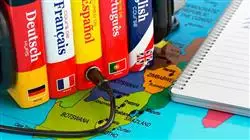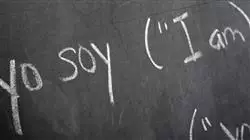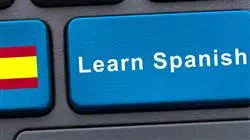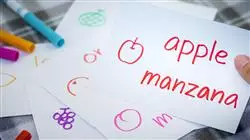University certificate
The world's largest faculty of education”
Introduction to the Program
This Postgraduate diploma in Methodology and Didactics of Teaching Spanish as a Foreign Language will generate a sense of confidence in the performance of your profession, which will help you grow personally and professionally"

The pedagogical proposal focuses on the adaptation of teacher training to social, pedagogical and technological changes. Just as students learn differently, teachers must also teach differently.
In educational terms, bilingualism refers to the use of two languages as a vehicle for teaching the content of one or more subjects within the curriculum.
In the teaching field, methodological trends and approaches not only require an adaptation in the way a second language is taught in the classroom, but also a new approach.
Foreign language teachers play an important role in bilingual programs, because the language they teach is now useful in other subjects or professional modules within the syllabus.
Update your knowledge through the program of Postgraduate diploma in Methodology and Didactics of Teaching Spanish as a Foreign Language"
The Postgraduate diploma in Methodology and Didactics of Teaching Spanish as a Foreign Language contains the most complete and up-to-date program on the market The most important features include:
- practical cases presented by practising experts in methodology and didactics of teaching Spanish as a foreign language
- The graphic, schematic, and practical contents with which they are created provide scientific and practical information on the disciplines that are essential for professional practice
- The latest updates on Methodology and Didactics of Teaching Spanish as a Foreign Language
- It contains practical exercises where the self-assessment process can be carried out to improve learning
- Special emphasis on innovative methodologies in methodology and didactics of teaching Spanish as a foreign language
- All of this will be complemented by theoretical lessons, questions to the expert, debate forums on controversial topics, and individual reflection assignments
- Content that is accessible from any fixed or portable device with an Internet connection
This Postgraduate diploma is the best investment you can make when selecting a refresher program, for two reasons: in addition to updating your knowledge in Methodology and Didactics of Teaching Spanish as a Foreign Language, you will obtain a Postgraduate diploma from TECH”
It includes in its faculty professionals belonging to the field of methodology and didactics of teaching Spanish as a foreign language, who bring their experience to this educational program, as well as recognized specialists belonging to reference societies and prestigious universities.
The multimedia content developed with the latest educational technology will provide the professional with situated and contextual learning, i.e., a simulated environment that will provide an immersive training program to train in real situations.
This program is designed around Problem-Based Learning, by means of which the Teachers must try to solve the different situations of professional practice that arise during the educational program. For this purpose, the teacher will be assisted by an innovative interactive video system created by renowned experts in the field of Methodology and Didactics of Teaching Spanish as a Foreign Language with extensive teaching experience.
Increase your decision-making confidence by updating your knowledge with this Postgraduate diploma"

Take the opportunity to learn about the latest advances in Methodology and Didactics of Teaching Spanish as a Foreign Language and improve the education of your students"
Syllabus
The objectives of this Postgraduate diploma are a response to the urgent need for ongoing learning of qualified professionals in the early stages of education who, in accordance with the principle of lifelong learning, need to recycle their knowledge and adapt their professional activity to new social demands, and who are massively aspiring to integrate their centers into the bilingual networks created by the administration.

The Postgraduate diploma in Methodology and Didactics of Teaching Spanish as a Foreign Language contains the most complete and up-to-date program on the market”
Module 1. The Spanish Linguistic System
1.1. Linguistic Variety of Spanish: Geographic or Diatopic Variety
1.1.1. General Principles
1.1.2. Geographic or Diatopic Variety
1.1.2.1. Language, Dialect, Speech and Accent
1.1.2.2. Spanish Dialects in Spain and Latin America
1.1.2.3. Spanish Dialects in Spain
1.1.2.3.1. Castilian or Castilian Spanish
1.1.2.3.2. Andalusian Spanish
1.1.2.3.2. Canary Islands Spanish
1.2. Spanish Dialects in Latin America
1.2.1. Caribbean Spanish
1.2.2. Mexican and Central American Spanish
1.2.3. Andean Spanish
1.2.4. Southern Spanish
1.2.5. Chilean Spanish
1.2.6. American Spanish
1.3. Linguistic Variety of Spanish: Situational Variety, Sociocultural or Diachronic Variety and Historical or Diachronic Variety
1.3.1. Languages in Contact
1.3.2. Situational or Diaphasic Variety
1.3.2.1. Language Registers
1.3.2.2. Slang and Jargon
1.3.3 . Sociocultural or Diastratic Variety
1.3.3.1. Social Levels of language
1.3.4. Historical or Diachronic Variety
1.3.4.1. A Journey from Medieval to Modern Spanish: Phonic and Morphosyntactic Features of Medieval Spanish.
1.4. Classic Spanish
1.4.1. Lexical Features of Medieval Spanish
1.4.2. Classical Spanish
1.5. Modern Spanish and Model of Spanish in the Classroom
1.5.1. Modern Spanish Spelling, Phonetics, Grammar and Lexicon
1.5.2. What Is Model Spanish in The ELE Classroom? (I)
1.5.2.1. The Varilex Project
1.6. Web Resources for Lexical Instruction and The Study and Teaching of Phonology and Phonetics
1.6.1. What Is Model Spanish in The ELE Classroom? (II)
1.6.1.1. CORDE, CREA, CORPES XXI, Educalingo and Audiolingua
1.6.2. Study and Teaching of Phonology and Phonetics
1.6.2.1. General Fundamentals of Phonetics and Phonology
1.6.2.2. Teaching Pronunciation
1.6.2.3. Determining Elements for Learning
1.6.2.4. Teaching Methods
1.7. Teaching Pronunciation and Teaching Spelling: Punctuation Marks
1.7.1. Adequate Pronunciation in the ELE Classroom
1.7.2. Using ICTs for Teaching Pronunciation in the Spanish as a Foreign Language Classroom
1.7.3. Orthography
1.7.3.1. Orthographic Signs: The Umlaut and The Prosodic Function of The Tilde
1.8. Teaching Spelling (I)
1.8.1. Diphthongs, Triphthongs and Hiatus Spelling
1.8.2. The Diacritical Function of The Tilde
1.8.3. Punctuation Marks
1.8.3.1. Speech Delimiters (I): Period, Comma and Semicolon
1.9. Teaching Spelling (II)
1.9.1. Discourse Delimiters (II): Colon
1.9.2. Delimiters of The Second Speech
1.9.3. Indicators of Modality or Omission of Statements
1.9.4. Auxiliary Signs: Hyphen, Slash and Apostrophe
1.9.5. Use of Uppercase and Lowercase Letters
1.9.6. Word Composition
1.9.7. Acronyms and Abbreviations
1.9.8. Foreign and Borrowed Words
1.10. Morphology (I)
1.10.1. Word Formation
1.10.2. Grammatical Categories (I)
1.10.2.1. The Noun
1.10.2.2. The Verb
1.10.2.3. The Adjective
1.10.2.4. The Adverb
1.11. Spanish Morphology (II) and Syntax
1.11.1. Grammatical Categories (II)
1.11.1.1. The Article and Personal Pronouns
1.11.1.2. Possessives
1.11.1.3. Demonstratives
1.11.1.4. Relatives, Interrogatives and Exclamatives
1.11.1.5. Indefinite and Numerical Quantifiers
1.11.1.6. Prepositions
1.11.1.7. Conjunctions
1.11.2. Syntax
1.11.2.1. The Spoken Voice
1.11.2.2. Sentence Classification
Module 2. Methodology and Didactics of Teaching Spanish as a Foreign Language
2.1. Skill-Based Learning of Spanish
2.1.1. General Skills
2.1.2. Linguistic Communication Skills
2.1.3. Programming Teaching Units According to Skills
2.1.4. Skills Evaluation
2.1.5. Rubrics to Assess Skills
2.1.6. Portfolio and Skills
2.1.7. Teaching Implications for the Spanish a Foreign Language Classroom
2.2. Planning of a Spanish Course
2.2.1. Common European Framework of Reference for Languages
2.2.2. Language Programs
2.2.3. Needs Analysis
2.2.4. Objectives
2.2.5. Assessment
2.2.6. Contents
2.2.7. Material and Manual Analysis
2.3. L2 Learning. Methods and Approaches
2.3.1. Methods and Approaches
2.3.2. Communicative Approach
2.3.3. L2 and Interaction
2.3.4. The Role of Emotions in L2 Learning
2.3.5. Problem-Based Learning
2.3.6. The Flipped Classroom
2.3.7. Gamification
2.3.8. Cooperative Learning
2.4. Literature in the Teaching of Spanish
2.4.1. The Role of Literature in the Spanish Classroom
2.4.2. Objectives of the Teaching of Literature
2.4.3. Literary Genres in Spanish Class
2.4.4. Dialogic Reading and Spanish as Foreign Language
2.4.5. Dialogical Literary Tertulias in the Spanish as a Foreign Language Classroom
2.5. Dialogic Learning in the Spanish as a Foreign Language Classroom Interactive Groups
2.5.1. Managing the Classroom
2.5.2. Group Dynamics and Their Phases
2.5.3. Group Dynamics in the Spanish a Foreign Language Classroom
2.5.4. Didactic Techniques in the Spanish a Foreign Language Classroom
2.5.5. Dialogic Learning
2.5.6. Interactive Groups
2.6. Teaching Written Language
2.6.1. Language Skills/Language Activities
2.6.2. Reading Comprehension Didactics
2.6.3. Activities to Develop Reading Comprehension
2.6.4. Teaching Didactics for Written Expression and Interaction
2.6.5. Activities to Develop Written Expression
2.6.6. Criteria to Evaluate Written Comprehension
2.6.7. Criteria to Evaluate Oral Comprehension
2.7. Oral Language Teaching
2.7.1. Listening Comprehension Didactics
2.7.2. Activities to Develop Listening Comprehension
2.7.3. Oral Expression and Interaction Didactics
2.7.4. Activities to Develop Oral Expression and Interaction
2.7.5. Criteria to Evaluate Oral Comprehension
2.7.6. Criteria to Evaluate Oral Expression
2.8. Lexicon Didactics
2.8.1. What is the Lexicon?
2.8.2. Lexicon Learning
2.8.3. Lexical Approaches and Communicative Teaching
2.8.4. Lexicon and Skills
2.9. Didactics of Linguistic Mediation
2.9.1. What Is Linguistic Mediation?
2.9.2. Background on Linguistic Mediation
2.9.3. Linguistic Mediation and Cultural Mediation
2.9.4. Typologies of Linguistic Mediation
2.9.5. Types of Linguistic Mediation in the Spanish as a Foreign Language Classroom
2.9.6. Mediatory Skills
2.9.7. Activities for Linguistic Mediation in the Spanish as a Foreign Language Classroom
2.10. Content Research and Creation Through the iPad/ Tablet
2.10.1. Tools for Searching for Information
2.10.2. Tools for Collaborative Work
2.10.3. Tools to Create, Edit and Transform
2.10.4. Tools to Develop Linguistic Skills
2.10.5. Tools for Evaluating
2.10.6. Apps for the Spanish a Foreign Language Classroom
2.10.7. Tools for the Inverted Spanish a Foreign Language Classroom
Module 3. Educational Resources for Teaching Spanish as a Foreign Language
3.1. Identification, Selection and Adaptation of Resources for Teaching Spanish as an L2
3.1.1. What Are Didactic Materials?
3.1.2. Types of Didactic Materials
3.1.3. Keys to Developing Materials
3.1.4. Adapting Didactic Materials
3.2. Didactic Resources: Flashcards and Pictures
3.2.1. Why Use Images?
3.2.2. How to Use Images in the Spanish as Foreign Language Classroom?
3.2.3. Types of Flashcards
3.2.4. Flashcard with Activities
3.3. Working with Graded Readings
3.3.1. Definition of Graded Reading and Characteristics
3.3.2. Advantages of Extensive Reading
3.3.3. Strategies for using Graded Reading in the Classroom
3.3.4. Activities with Graded Reading in the Classroom
3.4. Games, Activities and Board Games
3.4.1. Play
3.4.2. Games in Learning
3.4.3. Play in the Classroom
3.4.4. Gamification
3.4.5. Types of Games
3.5. Drama and Role Plays
3.5.1. Drama and Dramatic Play
3.5.2. Using Drama for Learning English
3.5.3. Differences Between Theatre and Dramatic Play
3.6. Poems, Rhymes, and Tongue Twisters
3.6.1. Why Use Poetry for Teaching L2 in the Classroom?
3.6.2. Rhymes
3.6.3. Tongue Twisters
3.7. Blogs and Wikis for Teaching Spanish as a Foreign Language
3.7.1. What Is a Blog?
3.7.2. Possibilities of Blogs in the Spanish as Foreign Language Classroom
3.7.3. Keys for Organizing and Designing a Blog
3.7.4. Examples of Blogs for Teaching Spanish as a Foreign Language
3.7.5. What Is a Wiki?
3.7.6. Uses of Wikis in the Spanish as Foreign Language Classroom
3.7.7. Examples of Wikis for Teaching Spanish as a Foreign Language
3.8. Didactic Worksheets in the Spanish as Foreign Language Classroom
3.8.1. What Are Didactic Worksheets?
3.8.2. Why Use Worksheets?
3.8.3. How to Use Worksheets in the Spanish as a Foreign Language Classroom?
3.8.4. Types of Worksheets
3.8.5. Adaptation, Design and Creating Worksheets
3.9. Didactic Resources: iPads and Tablets to Teach Spanish as a Foreign Language
3.9.1. iPads/Tablets in a Language Classroom
3.9.2. Apps for the Classroom
3.9.3. Specific Apps to Learn Spanish
3.9.4. Online Resources
3.10. Didactic Resources: Videos and Films
3.10.1. Why Use Short Animation Films?
3.10.2. Keys to Using Short Films in the English Classroom?
3.10.3. How to Choose a Short Film?
3.10.4. Activities to do Before, During, and After the Viewing

A unique specializacion program that will allow you to acquire advanced training in this field"
Postgraduate Certificate in Methodology and Didactics of the Teaching of Spanish as a Second Language
Expand your horizons as a teaching professional with TECH Global University's Postgraduate Certificate in Methodology and Didactics of Teaching Spanish as a Second Language. Our online classes will provide you with the necessary tools to become an expert in teaching Spanish as a second language. At TECH Global University, we pride ourselves in providing a quality education that fits your needs. With our Postgraduate Certificate in Methodology and Didactics of Teaching Spanish as a Second Language, you will develop a solid theoretical and practical foundation for teaching Spanish to non-native students. The online classes offer a flexible and convenient educational experience. You will be able to access course content from anywhere and at any time, adapting your studies to your own pace and schedule. Make the most of your time and gain the skills you need to excel in the field of language teaching. You will explore diverse methodologies and pedagogical approaches adapted to the learning needs of learners of Spanish as a second language. You will learn effective strategies to foster oral and written communication, improve listening comprehension and promote linguistic fluency in your students.
The most modern methodology in the market is handled by TECH
You will analyze the specific characteristics of teaching Spanish as a second language and discover how to design attractive teaching materials suitable for different learning contexts. You will master the techniques of evaluation and monitoring the progress of your students, allowing you to offer effective and personalized teaching. With the Postgraduate Certificate in Methodology and Didactics of Teaching Spanish as a Second Language from TECH Global University, you will be prepared to open new job opportunities in the field of language teaching. Stand out as a trained professional committed to quality education. Your future in teaching Spanish as a second language starts here!







